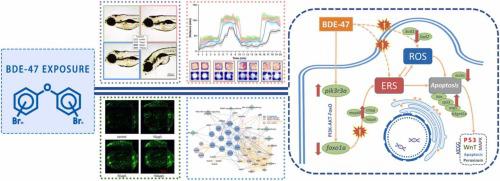Ecotoxicology and Environmental Safety ( IF 6.2 ) Pub Date : 2023-10-25 , DOI: 10.1016/j.ecoenv.2023.115615 Shukai Zheng 1 , Qiong Zhang 2 , Xiaoling Shi 2 , Congying Luo 2 , Jiasheng Chen 1 , Wancong Zhang 1 , Kusheng Wu 2 , Shijie Tang 1

|
Polybrominated diphenyl ether flame retardants are known to have adverse effects on the development of organisms. We investigated the molecular mechanisms associated with the developmental hazards of 2,2′,4,4′-tetrabromodiphenyl ether (BDE-47) in zebrafish, as well as the behavioral and morphological alterations involved, focusing on endoplasmic reticulum stress (ERS), oxidative stress, and apoptosis. Our study revealed behavioral alterations in zebrafish exposed to BDE-47, including impaired motor activity, reduced exploration, and abnormal swimming patterns. In addition, we observed malformations in craniofacial regions and other developmental abnormalities that may be associated with ERS-induced cellular dysfunction. BDE-47 exposure showed apparent changes in ERS, oxidative stress, and apoptosis biomarkers at different developmental stages in zebrafish through gene expression analysis and enzyme activity assays. The study indicated that exposure to BDE-47 results in ERS, as supported by the upregulation of ERS-related genes and increased activity of ERS markers. In addition, oxidative stress-related genes showed different expression patterns, suggesting that oxidative stress is involved in the BDE-47 toxic effects. Moreover, an assessment of apoptotic biomarkers revealed an imbalance in the expression levels of pro- and anti-apoptotic genes, suggesting that BDE-47 exposure activated the apoptotic pathway. These results highlight the complex interactions between ERS, oxidative stress, apoptosis, behavioral alterations, and morphological malformations following BDE-47 exposure in zebrafish. Understanding the mechanisms of toxicity of developmental hazards is essential to elucidate the toxicological effects of environmental contaminants. The knowledge can help develop strategies to mitigate their adverse effects on the health of ecosystems and humans.
中文翻译:

2,2′,4,4′-四溴二苯醚诱导的内质网应激对斑马鱼生命早期阶段的发育危害
已知多溴二苯醚阻燃剂对生物体的发育有不利影响。我们研究了与 2,2',4,4'-四溴二苯醚 (BDE-47) 对斑马鱼发育危害相关的分子机制,以及所涉及的行为和形态改变,重点关注内质网应激 (ERS)、氧化应激和细胞凋亡。我们的研究揭示了暴露于 BDE-47 的斑马鱼的行为改变,包括运动活动受损、探索减少和游泳模式异常。此外,我们观察到颅面部区域的畸形和其他发育异常可能与 ERS 诱导的细胞功能障碍有关。通过基因表达分析和酶活性测定,BDE-47暴露显示斑马鱼不同发育阶段的ERS、氧化应激和细胞凋亡生物标志物发生明显变化。研究表明,接触 BDE-47 会导致 ERS,这得到了 ERS 相关基因上调和 ERS 标记活性增加的支持。此外,氧化应激相关基因表现出不同的表达模式,表明氧化应激参与了BDE-47的毒性作用。此外,对凋亡生物标志物的评估显示促凋亡基因和抗凋亡基因的表达水平不平衡,表明 BDE-47 暴露激活了凋亡途径。这些结果强调了斑马鱼暴露于 BDE-47 后 ERS、氧化应激、细胞凋亡、行为改变和形态畸形之间的复杂相互作用。了解发育危害的毒性机制对于阐明环境污染物的毒理学作用至关重要。这些知识可以帮助制定战略,减轻其对生态系统和人类健康的不利影响。


















































 京公网安备 11010802027423号
京公网安备 11010802027423号